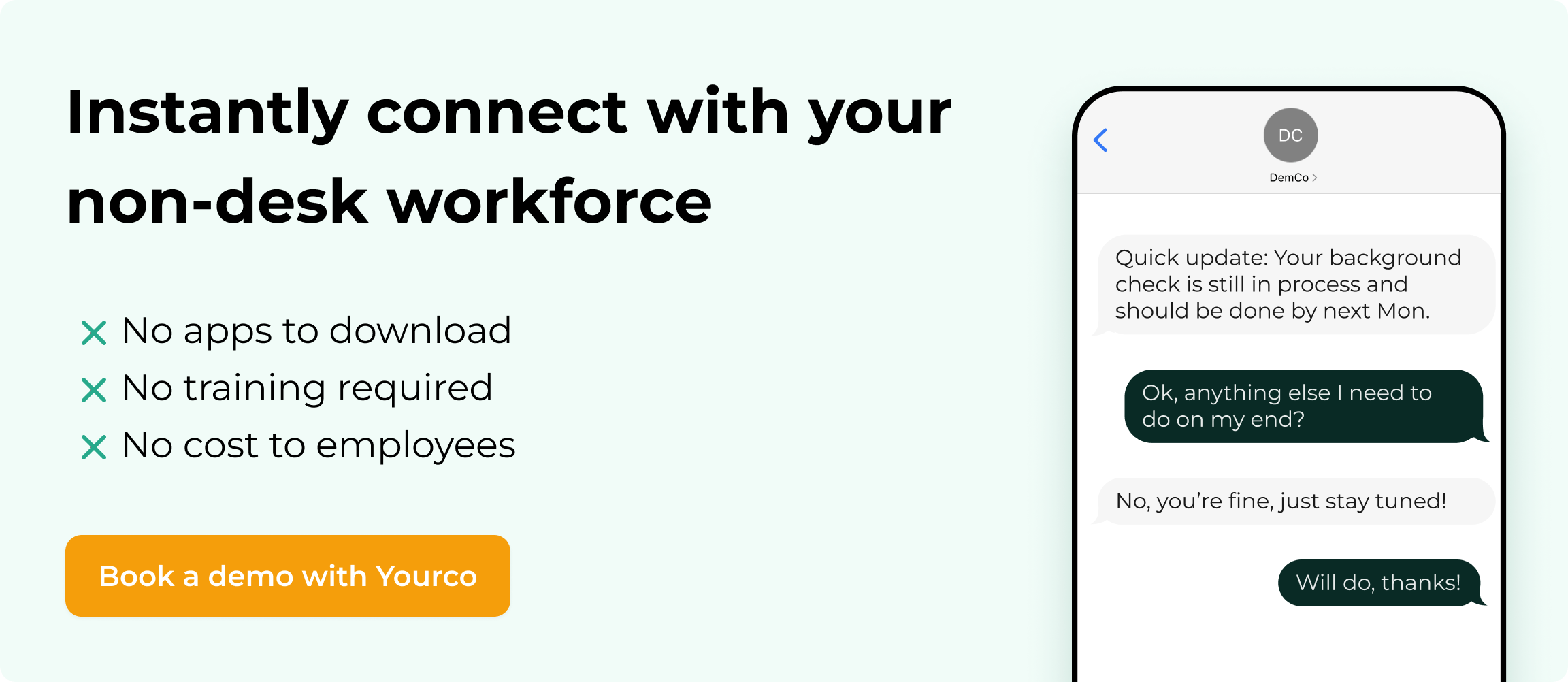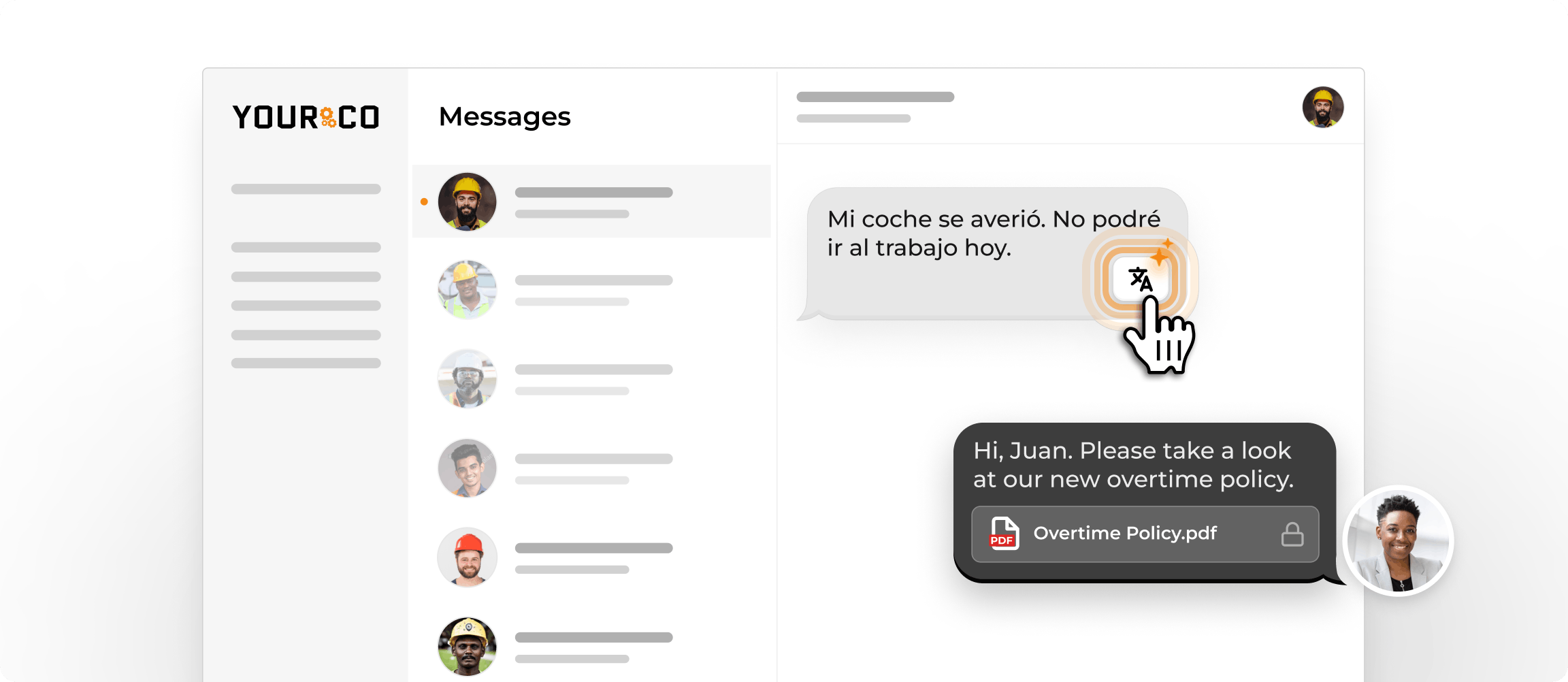The Manager’s Toolkit for Handling Call-Offs


When a worker texts "I'm out sick" at 5:37 a.m., you have minutes to keep the line moving. That single message triggers a scramble of phone calls, spreadsheet edits, and last-second favors that can stall production, spike overtime wages, and drain morale before the day even starts.
Without a dependable way to log call-offs and alert replacements, each absence ripples through schedules, compliance rules, and safety operating procedures, turning a routine shift into a costly juggling act.
This playbook transforms that chaos into a controlled process, with a toolkit built for industries where jobs can't wait for deskbound email threads — manufacturing plants, logistics hubs, construction sites, and any operation that relies on skilled, on-site labor. Digital solutions are reshaping absence management, from simple text systems with high read rates within minutes to centralized logs that give you real-time visibility into every call-off.
You'll learn how to standardize call-off codes, automate alerts, reassign shifts, track patterns for proactive staffing, and stay audit-ready, all while treating employees fairly and keeping operations on schedule.
Why Last-Minute Call-Offs Create Bigger Problems Than You Think
When someone texts "I'm not coming in" an hour before their shift, the disruption goes far beyond one empty workstation. You suddenly have to reshuffle people, rebalance workloads, and still hit the day's targets, all while keeping everyone safe and compliant.
A single absence can stall an entire production line or hold up a construction task. If the missing employee runs a critical machine or operates a crane, the whole team waits. In desk-based settings, last-minute absences also cause a ripple effect. Project timelines shift, meetings get canceled, and client work slows down, especially when key decision-makers or communicators are missing.
To keep output flowing, you probably lean on the rest of the crew. Piling extra work onto already busy teammates increases fatigue and the risk of mistakes or injuries. Also, constant coverage gaps erode engagement and accelerate turnover, creating a cycle of more call-offs.
Frequent call-offs also chip away at morale. Colleagues who repeatedly cover absent coworkers may feel taken advantage of, fueling resentment and driving their own absenteeism. Over time, what began as a few sporadic sick days can spiral into a culture where calling out becomes the norm rather than the exception.
Rushed fixes also carry compliance risks around industrial regulatory compliance. When you reassign shifts on the fly, it's easy to blow past overtime limits, overlook certification requirements, or violate break rules. For industries already battling labor shortages, these missteps can invite fines and create safety hazards.
By recognizing the true scope of these impacts, you can justify investing in a smarter, more consistent approach to absence management — one that prevents a simple text from snowballing into a full-day crisis.
What a "Toolkit" for Absence Management Should Include
When an employee is unable to attend work on a given day, you need a system that converts that call-off into a clear action plan. A solid absence-management toolkit helps you document the absence, find coverage, and keep production moving without the usual scramble.
Digital Call-Off Log
Start with a digital call-off log that captures every message the moment it arrives. When an employee sends a text, the system records the exact time, saves their message, and tracks your response. This creates a complete record you can access instantly, so there's never confusion about who said what or when something happened. To maintain consistency and ensure searchability, use a single, documented channel for reporting absences — ideally, an SMS system with auto-logging capabilities.
Standardized Absence Reason Codes
Next, use standardized absence reason codes, such as "illness," "family emergency," or "transportation." These codes help you run consistent reports and spot trends across departments. Real-time dashboards in absence analytics platforms turn these patterns into actionable insights, so you can plan ahead instead of constantly reacting.
Mobile-Friendly Call-Off System
Since most non-desk employees use basic mobile phones, your toolkit should be compatible with SMS without requiring app downloads. If a worker can send a text, they can report an absence. A simple browser-based dashboard on your end completes the system, whether you're on the plant floor or working from home.
That said, some HR leaders worry that SMS might make it too easy to call off and open the door to misuse. The key is to set clear expectations: define when a call-off via text is acceptable, and what follow-up is required. For example, after a certain number of last-minute absences, you might require a doctor’s note or written documentation. SMS should be a tool for transparency and accountability, not a shortcut around your policies.
Real-Time Alerts and Notifications
Speed matters once the call-off arrives. Real-time late employee alerts should reach supervisors and potential replacement workers instantly, not sit in voicemail for hours. Workforce platforms, such as Yourco, are designed for labor-shortage environments and automatically route these alerts to the right people, cutting your coverage time from hours to minutes.
Shift Reassignment and Overtime Tracking
Effective shift-reassignment tools show who's available, who's certified for the task, and how the change affects overtime limits. When paired with automatic schedule updates, you avoid both staffing gaps and surprise wage costs. If overtime becomes unavoidable, a quick overtime calculator lets you verify pay before approving any extended shifts.
Built-In Compliance and Documentation
Every interaction should support compliance and future planning. Automated documentation feeds absence analytics that highlight rising no-show rates, late notifications, or patterns like frequent Monday sick calls. These alerts give you time to address issues before they become chronic problems.
Prewritten Communication Templates and Escalation Flows
Consistent communication templates tie everything together. Pre-written texts for call-off confirmations, required documentation, or return-to-work instructions ensure each employee gets the same clear message in their preferred language. For example, when an employee texts in sick, having a standardized response ready keeps the process fair and stress-free. Build escalation protocols that trigger after a set number of infractions — the system flags the pattern, notifies HR, and automatically schedules the next conversation.
With these elements working together, you'll replace frantic early-morning phone calls with a reliable process that protects production, controls costs, and maintains team morale.
Benefits of Moving Call-Offs Online
Shifting your call-off process from phone trees and paper logs to an online system turns frantic early mornings into a predictable, documented workflow that saves time, cuts costs, and treats every employee the same. Here's what you gain:
- Instant documentation: Digital platforms time-stamp every message, attach the employee's reason code, and alert the right people the moment a shift is at risk.
- Enhanced Speed: Text-based systems reach workers fast — 98% of SMS messages are read, and 90% within five minutes, so you can lock in a replacement before the line even starts up. Teams using SMS call-off workflows have better communication efficiency, which translates into fewer production delays and less paid idle time.
- Straightforward compliance: Every interaction is stored in one searchable log, so you can pull a full absence history, complete with manager responses, when auditors, insurers, or union reps ask for documentation.
- Improved fairness: Digital systems enforce standardized workflows, ensuring the same text template, the same reason codes, and the same confirmation sent back. That consistency strips out favoritism and the perception of "special treatment," which can be a morale killer.
- Actionable data insights: Because every absence is categorized in real time, you can spot patterns, like a spike in call-offs during the Friday night shift or a cluster around a certain supervisor, and fix root causes before they grow. Quick insights like these are almost impossible when you're chasing paper trails. With Yourco's Frontline Intelligence, absence data is automatically logged, categorized, and visualized across locations, departments, and shifts. The platform surfaces patterns without requiring manual tracking. HR teams get dashboards that show which teams are consistently understaffed, which shifts see the most last-minute call-offs, and even whether certain absence types are increasing over time.
- Seamless integration: Modern call-off platforms feed approved absences straight into your scheduling, HRIS, and payroll tools, eliminating double entry and paycheck errors. For non-desk teams without easy email access, SMS keeps everyone in the loop without forcing them to download an app or hunt for Wi-Fi.
When you combine benefits such as instant coverage, accurate records, visible patterns, and seamless data flow, moving call-offs online isn't just an upgrade. It's the difference between firefighting and running a smooth, predictable operation.
Common Pitfalls to Avoid
As you move your call-off process online, it's important to watch out for habits that can undercut the system you're building. These are two of the most common mistakes:
- Accepting verbal call-offs with no written trail: Phone calls without documentation leave you open to disputes and make it harder to track absences reliably. Every call-off should leave a time-stamped record.
- Letting supervisors use informal side-channels: When managers accept call-offs through personal texts, WhatsApp, or DMs, it creates inconsistency and confusion, and opens the door to favoritism. Stick to a single, documented channel, such as SMS or an online form, to ensure every call-off is handled consistently.
Avoiding these habits reinforces fairness, protects your records, and ensures your system delivers on its promise of clarity and control.
Tools That Help Handle Call-Offs (and What to Look For)
Choosing the right platform turns daily call-off chaos into a predictable, trackable process. You'll find dozens of absence tools on the market, but several names surface consistently when operations managers discuss what actually works in the field.
- Yourco brings a real strength: fast, SMS-based communication for non-desk teams, functioning much like the employee communication apps office staff use. Because every worker already carries a phone, text workflows capture call-offs in seconds and store a time-stamped audit trail.
- When I Work keeps shifts moving with drag-and-drop scheduling and quick swap approvals.
- UKG scales to enterprise head counts, layering complex compliance rules on top of time-off tracking and payroll—its depth consistently earns high marks in industry reviews.
- BambooHR wraps PTO tracking into a broader HR suite that small and mid-size companies already know and trust.
- Deputy focuses on rapid shift coverage, helping you backfill openings before production slows.
No single tool fits every organization, but the best ones combine speed, simplicity, and reliability. Once you’re clear on what your team needs most, it’s easier to compare options and find the right fit.
How to Choose The Best Tool for Your Team
Choosing the right absence management platform starts with knowing your team’s needs, especially if they work in the field, on rotating shifts, or across multiple locations. Here’s what to look for:
- Prioritize mobile accessibility: Staff must be able to report absences from any phone, even without data access or a company email. SMS-based tools excel here — no log-ins, no apps. For a forklift driver starting at 5 a.m., texting “Out sick, have fever” is far easier than navigating a voicemail maze.
- Keep the interface simple: Managers juggling equipment and paperwork don’t have time to dig through clunky software. Choose a system with a clean, intuitive dashboard that highlights what's urgent, such as missed punches, open shifts, or unconfirmed absences.
- Look for integration with core systems: The best tools connect directly to your HRIS, payroll, and scheduling software, eliminating double entry. This keeps data clean and ensures shift changes, absence codes, and pay adjustments flow seamlessly across systems.
- Use analytics to stay ahead: Choose a platform with real-time analytics that flag recurring absence patterns, overtime spikes, and policy exceptions or compliance risks. These insights help you act before costs climb or coverage gaps grow.
- Customization matters: Every contract and department has different needs. Your tool should let you define custom reason codes, set union thresholds, translate messages into multiple languages, and configure escalation workflows. Flexibility here ensures the system fits your policies, not the other way around.
- Compare cost vs. coverage speed: Weigh per-employee fees against what you'll save by avoiding overtime or missed production. Faster shift-filling often justifies the investment within weeks.
- Implementation should be fast: Modern cloud platforms don’t take months to launch. Most teams can import rosters, test core workflows, train key user, and go live in 2 to 4 weeks through phased rollout.
- Don’t overlook security: Make sure the platform encrypts data in transit and at rest, offers role-based access, and stores message logs for the time period your auditors expect. That way, you protect employee privacy while staying compliant with labor and industry regulations.
At the end of the day, the best tool is the one your team will actually use — quickly, easily, and without confusion. If it makes everyone's job a little smoother, you’ve found the right fit.
Using Data to Improve Staffing and Scheduling
Spotting absence patterns is the fastest way to start fine-tuning your schedule. By turning raw call-off logs into insights, you can predict when coverage will be tight, line up replacements in advance, and keep production humming.
Start by looking for simple patterns. Dashboards show if call-offs cluster on certain days, seasons, or departments. A spike in Monday absences or post-holiday no-shows usually points to fatigue or burnout. Once you know the "when" and "where," you can tailor interventions. This could include rotating high-strain tasks, offering wellness days, or shifting start times.
Historical trends also feed reliable forecasts. If last year's summer heat drove a 12% uptick in warehouse call-offs, you can schedule extra floaters this July or approve overtime budgets early. Modern HR systems surface these risks automatically, flagging them weeks before they cost you output.
Data also arms you to build smarter float pools. Instead of keeping a blanket list of on-call workers, track which certifications or machine skills go missing most often. Cross-train against that gap, then use your scheduling tool to tag those employees as priority backups. If you need executive sign-off to pay for training, attendance reports showing reduced overtime after cross-training make a compelling case.
Key metrics to watch every week:
- Absence rate per team or location
- Average time to fill an open shift
- Overtime hours triggered by call-offs
- Schedule accuracy (planned vs. worked hours)
- Cost of temporary labor as a share of total wages
Tracking these KPIs shows whether your policies are shrinking coverage gaps or simply shuffling them around.
Predictive analytics can prevent understaffing altogether. When the system projects a shortage two Fridays from now, you can approve lighter production quotas, reassign overtime volunteers, or schedule preventive maintenance during the lull. Over time, those adjustments translate into steadier output and a calmer crew.
Handle Absences Smoothly and Keep Your Day on Track
Absences will always pop up, but they don't have to derail your day. When you follow a clear playbook with standardized reason codes, real-time alerts, automated documentation, and data-driven scheduling, you turn chaotic call-offs into routine tasks. Each piece of the toolkit works together: consistent reporting feeds clean data, clean data powers smarter staffing, and smarter staffing protects productivity and wages.
If you still rely on phone chains or spreadsheets, the fastest upgrade is moving call-offs to text. SMS-based platforms such as Yourco make this simple. Employees call out by text — no apps or logins — and managers get instant alerts, not voicemails. Every message is automatically time-stamped, categorized, and archived, so nothing gets missed. You also get built-in shift broadcasts, multilingual support for 135+ languages, and clean data you can actually use to spot trends and improve staffing.
Don’t let last-minute call-offs throw off your day. Try Yourco for free today or schedule a demo and see the difference the right workplace communication solution can make in your company.
Frequently Asked Questions
Do SMS platforms cost extra per text?
At Yourco, we keep it simple and predictable. Our pricing is a flat monthly fee based on the number of employees, no per-message charges, no surprise overages.
How long does data stay accessible for audits?
Retention policies vary. Many platforms keep message logs for at least seven years—long enough to satisfy most labor and insurance audits.
Do I need advanced AI to see results?
No. You don’t need complex AI to start seeing real impact. Pattern charts and conditional formatting can reveal the majority of problem areas. That said, Yourco’s Frontline Intelligence takes it a step further by speeding up detection and delivering proactive alerts when trends emerge. Instead of digging through spreadsheets, you get instant visibility into patterns, so you can act sooner and with more confidence.
What are the key questions to consider when designing call-off procedures across multiple sites?
When you're building procedures that span multiple locations, it’s important to ask a few foundational questions. What system can be used company-wide to ensure consistency — such as an SMS line or a shared online form? Who will be responsible for confirming and logging each absence? How will backup coverage be triggered and tracked? And how can you ensure compliance with labor rules like overtime or certifications across every shift?
Thinking through these questions upfront helps you create a scalable process that’s both standardized and flexible.
Who is allowed to approve or deny call-offs?
Call-offs are typically approved or denied by direct supervisors or shift leads, depending on the structure of your team. If the call-off involves multiple days or touches on broader policy issues, HR should step in. To avoid confusion, your policy should clearly spell out who has authority at each step of the process.




